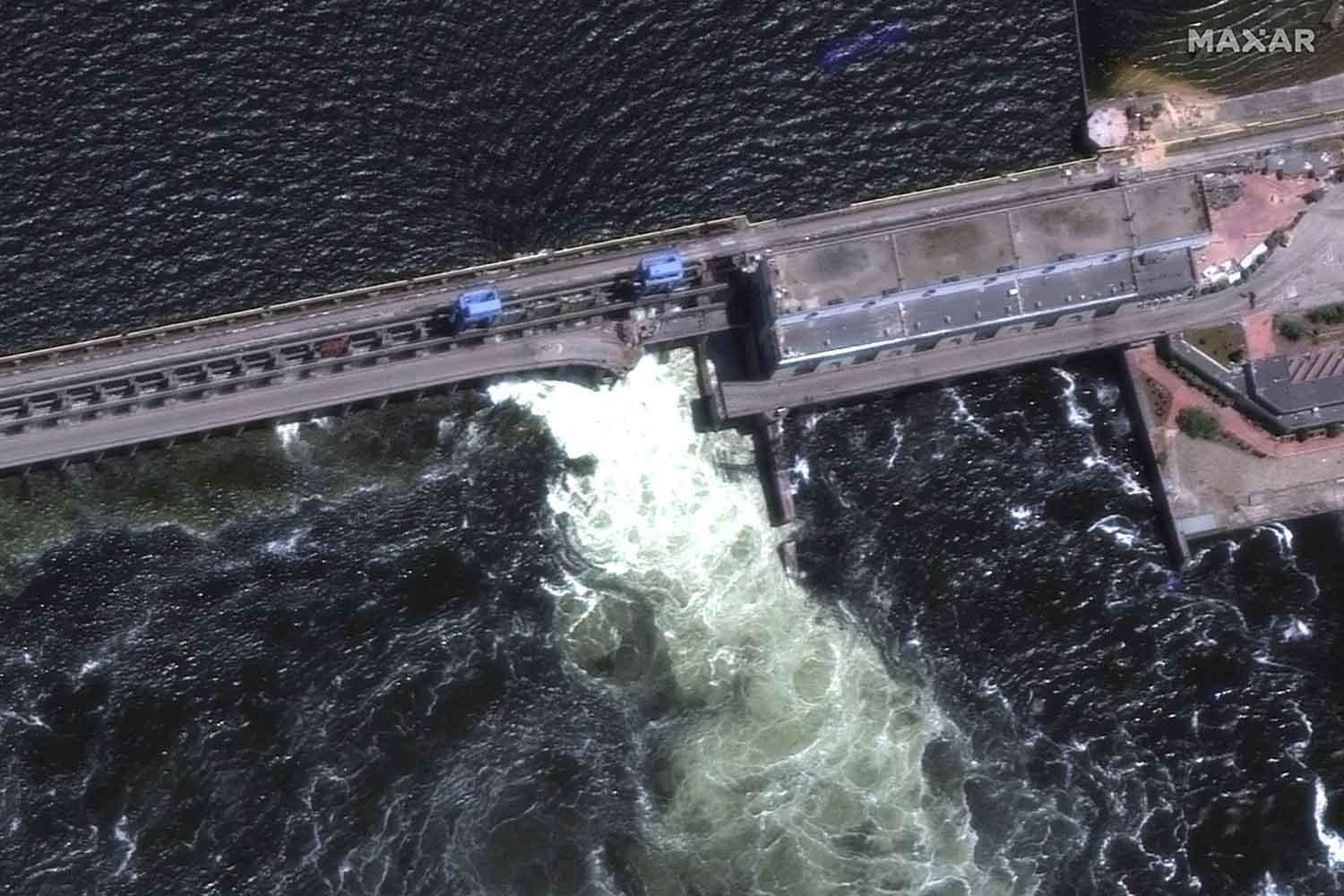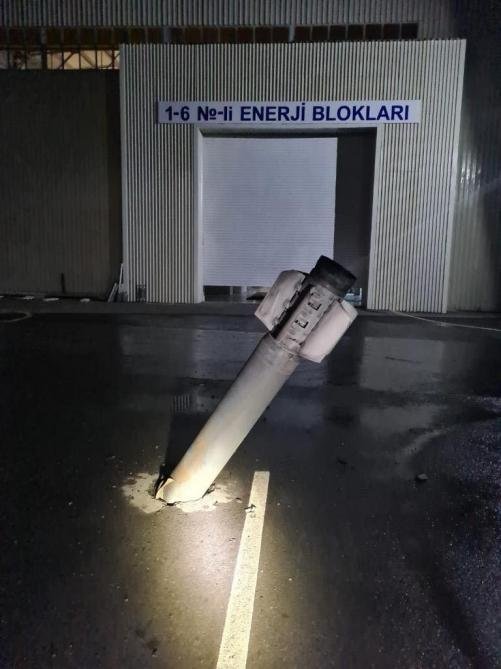Water dam incidents in Ukraine and Azerbaijan International community’s biased “all for one” strategy
The war in Ukraine once again made the headlines this week after a hydropower plant (HPP) on the Dnipro River in the Russia-controlled part of the Kherson region collapsed unleashing heavy floods that led to immediate evacuations.
A massive breach in the Soviet-era Kakhovka dam caused destructive flooding in the low-lying areas on either side of the river Dnipro. According to UN estimations, at least 16,000 people lost their houses as a result of the disaster.
Ukraine blamed Russia for wrecking the water reservoir, while Moscow repulsed the accusations back to Kyiv. According to the Ukrainian version of the incident’s motives, Russia may have feared that Ukrainian forces would use the road over the dam to get troops across the river into Russian-held territory, as part of a counter-offensive and deliberately blew up the HPP.
Ukrainian dam operator UkrHydroEnerho said the Kakhovka station was "fully destroyed" without room for restoration.

The Khakovka dam after the recent incident
There was an immediate international reaction to the disaster at the water reservoir. UN Secretary-General Antonio Guterres said the dam’s destruction was a “monumental humanitarian, economic, and ecological catastrophe”. In an immediate response, the EU began channelling aid via its Civil Protection Mechanism supported by Germany, Austria, and Lithuania. Germany has offered 5,000 water filters and 56 generators, and Austria 20 water containers and 10 mud water pumps, which were shipped to Ukraine on June 7. Moreover, Lithuania and Germany have also offered shelter equipment, including tents, beds, and blankets.
Josep Borrell, the EU's foreign policy chief, and Janez Lenarčič, European Commissioner for crisis management, called the incident “an unprecedented level” of Russia’s attacks on the civilian infrastructure in Ukraine. Roberta Metsola, president of the European Parliament, the European Commission President Ursula von der Leyen, NATO Secretary General Jens Stoltenberg, Spanish Prime Minister Pedro Sánchez, Czech Prime Minister Petr Fiala, Croatian Prime Minister Andrej Plenković, Danish Prime Minister Mette Frederiksen, Romanian President Klaus Iohannis and Lithuanian President Gitanas Nausėda also voiced their concerns and condemnation over the disaster.
Robert Wood, the Head of the US Mission to the UN, said the Khakovka dam’s destruction risks massive ecological devastation, while also announcing that Washington has been in close touch with Ukraine to discuss swift humanitarian assistance to the affected people.
In the meantime, the Kakhovka dam incident in Ukraine triggers a time travel back to 2020 when Azerbaijan faced similar threats by Armenia but an international reaction was missing on the horizon.
"See not, hear not, speak not"
The decades-old conflict between Armenia and Azerbaijan, with its roots in Armenia’s territorial claims and ensuing war against its neighbour, spiralled on September 27, 2020, after Armenian forces deployed in the then-occupied Azerbaijani lands launched a full-scale offensive.
The counter-attack measures taken by the Azerbaijani military catapulted the largest hostilities the South Caucasus region has not seen since 1994. The war continued for 44 days. During counter-attack operations, Azerbaijani forces liberated over 300 settlements, including the cities of Jabrayil, Fuzuli, Zangilan, Gubadli, and Shusha, from a nearly 30-year-long illegal Armenian occupation. The war ended in a statement signed on November 10, 2020, under which Armenia returned the occupied Aghdam, Kalbajar, and Lachin districts to Azerbaijan.
At the height of clashes in October, Armenian troops launched a missile attack on the central Azerbaijani city of Mingachevir, which hosts the country's largest hydroelectric power plant and water reservoir. The missile landed in close proximity to the plant’s energy block but did not explode. The Azerbaijani side confirmed no damage to the facility’s infrastructure, however, reported injuries among civilians.
But a photo of an unexploded missile stuck in the ground metres away from the energy block’s gate did not prompt any reaction from today’s messengers of the Ukraine war, including the EU, the US, the UN and other international “condemners”. They have kept silent also despite the further threats by the Armenian military to use ballistic missiles against Azerbaijan.

Armenian missile that fell near the energy block of Azerbaijan's Mingachevir NPP in 2020
Armenian officials have identified the water reservoir in Mingachevir as a military long before the 2020 war. Over the 30 years of illegal occupation of the Azerbaijani lands, military officials in Armenia and a self-proclaimed separatist regime established illegally in the Karabakh region have repeatedly threatened to blow up the Mingachevir dam as part of attacks on civilian infrastructure in Azerbaijan.
Mingachevir hydropower complex is the largest dam of its kind in the entire Caucasus with an overall surface area of 605 square kilometres (234 sq mi), roughly the same size as Spain's capital Madrid. The installed power generation capacity of the station is 402 megawatts which enables it to churn out 1.4 billion kilowatt-hours (kWh) of hydroelectric energy per year. The complex provides energy for over forty cities and districts in Azerbaijan including the capital Baku and the second-largest city of Ganja.
The consequences of a possible strike on the Mingachevir reservoir could be quite catastrophic for Azerbaijan and the entire region. Officials at the National Center of Environmental Forecasting insist that water from the destroyed dam could inundate a huge territory in Azerbaijan stretching from the country's central part toward the east up to the capital Baku over 240 kilometres. Such damage could lead to dramatic environmental, infrastructure and humanitarian disasters, which could kill countless civilians.
Around half of the population of Azerbaijan could suffer a massive power outage. Strategic transport and energy routes, such as the Baku-Tbilisi-Kars railway, the Baku-Tbilisi-Ceyhan oil, and the South Caucasus gas pipelines could get serious damage in the wake of the dam burst.
During the 2020 war, Armenian forces launch intensive missile attacks also on Azerbaijan’s second-largest Ganja, as well as the cities of Barda, Tartar, and Beylagan. Separately, they also hit the Khizi-Absheron region near Azerbaijan’s capital Baku with mid-range missiles. The rocket fires on Ganja on October 4, 5, 8, 10, and 17 killed 32 civilians and injured 125 others.
A missile attack by Armenia on the second-largest Ganja city of Azerbaijan in 2020
The forerunners of the international community again failed to come up with a timely and adequate response to the civilian terror in Azerbaijan by Armenia. However, the top officials in Europe, the US, and the UN have been campaigning for an international assessment of the Russian missile strikes in Ukraine.
Ecological terror
According to the preliminary estimates, the environmental crimes by Armenia in the once-occupied Azerbaijani lands caused $285 billion in damages. Five gold deposits and other natural resources of Azerbaijan in those lands have been intensively looted by the local Armenian companies and those invited from overseas. Companies such as Vallex Group, First Dynasty Mines, Base Metals, Lydian International, GeoProMining, Vedanta Group, and Armenian-descent businessmen and entrepreneurs had been involved in illegal mining operations in the Azerbaijani lands.
The contamination of the Okhchu River, one of the eleven rivers of Azerbaijan in the Karabakh region, which is home to more than 30 per cent of the country’s overall drinking water reserves, has also been a great concern for the Azerbaijani authorities over the years. The Okhchu River is said to be used as a “collector” by Armenia’s producers for sending away the industrial wastes from the country’s territory and causing agricultural, environmental, and humanitarian disasters in Azerbaijan. The analysis of the samples taken from the Okhchu River revealed many life-threatening elements in the water, including copper, molybdenum, manganese, iron, zinc, and chromium.
Today, Armenians have all but completely drained the Sarsang water reservoir in the Tartar region of Azerbaijan. The resources of the reservoir have been massively used for electricity generation turning the waterbody into a desert-like field covered in soil cracks.
The latest view from the Sarsang water reservoir
There was no strong international condemnation of Armenia’s military, civilian, and ecological terror in the Azerbaijani lands since their occupation in the 1990s. The UN failed to fetch the fulfilment of its legally binding resolutions on the occupation of the Azerbaijani lands for 30 years, sticking only to verbal statements, recommendations, calls, and other actions of a similar type. The OSCE and its Minsk Group, co-chaired by the US, France, and Russia, turned the mediation task into a shuttle diplomacy that did not bring any breakthrough in the former Karabakh conflict’s settlement.
In a nutshell, the international community is seemingly biased in its “all for one” strategy by picking the “one” based on its personal interests. Otherwise, it would have been otherwise ...








